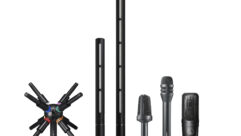
Audio Outfittings for Urban Outfitters, Part 1
Nov 15, 2011 10:12 AM,
with Bennett Liles
Listen to the Podcasts
Editor’s note: For your convenience, this transcription of the podcast includes timestamps. If you are listening to the podcast and reading its accompanying transcription, you can use the timestamps to jump to any part of the audio podcast by simply dragging the slider on the podcast to the time indicated in the transcription.
When Urban Outfitters chose to have a sound system installed in a former steel bending shop with multiple events going on in the same space, the company called on DBS Audio to solve that very tricky acoustic problem. Michael Shoulson is here to explain how DBS Audio tackled the job and came out with the ultimate in sound control and management coming right up on the SVC Podcast.
SVC: Michael, thanks for being with me on the SVC Podcast. This was a very challenging installation by DBS Audio in a former naval shipyard complete with concrete floors and exposed steel and glass and some pretty tough acoustics. But first of all, tell me something about DBS Audio.
DBS Audio was started in 1992 by David Brotman, and he had been taping for years and he had been following, to some extent, The Grateful Dead and a lot of other bands, and it was either get off the road or do something with your life, and he loved music. There was a love of music and of quality, and I think that also led to choosing Meyer Sound as our primary speaker manufacturer. So the company was started in 1992, and we started off as a live sound company, and over the years we have grown to do a lot more installations. We do regional touring; festivals have always been our specialty in the live sound arena, and so we’ve grown over the last six or seven years, and we started doing installations for a couple of schools. University of Vermont being one of them, and then we did a line of stores for Abercrombie and Fitch. We did their rural stores, which was their 30-something line and have just been going from there and doing larger and larger installations and live productions. [Timestamp: 2:11]
And this one was in a very tough environment. What did you think when Urban Outfitters came to you and said they wanted a good sound system put into what I believe had been a steel plate or pipe bending shop in the Philadelphia Naval Shipyard. That doesn’t sound like a friendly place for sound.
We’ve been doing live production for Urban, I think, since 2003, [which] is when we started doing their Christmas parties, and as that company has grown, they have been buying more and more buildings in the naval yard. The building [for] this installation, building 543, was a pipe-bending shop, and we’d had some experience working in there in the past bringing in large-format PAs for live events and for events; they use it primarily as a fundraising space—for charities and stuff like that. They were starting to look for ways to make it more affordable to use it as a charity because for us to bring in sound, lighting, and staging and video and everything else that you might need for an event, it got cost-prohibitive. [Timestamp: 3:17]
Yeah. Especially in that place.
Oh yeah, it’s big from a live sound point of view and even for the installation because there’s steel everywhere, so it’s a rigger’s dream. It is probably an acousticians nightmare because everything is polished concrete, a lot of glass everywhere. So you can drop a pin at one end of the building and you’ll practically hear it at the other. So luckily we have a lot of experience working in that building and the client is a great client to work with. They’ve always been very friendly and very easy to work with on our end, and it was a very long process; I think we started talking about a permanent installation in 2006. This design came about in 2009, and it wasn’t until the go-ahead—I think we started at the very end of January of 2011 is when we started we finished up the installation at the very beginning of April. [Timestamp: 4:16]
Well, you said it was a rigger’s dream. There must have been some architectural challenges getting wiring run, speakers placed and all that.
For speaker placement, we got fairly lucky because there is steel everywhere; we could clamp on or bolt on throughout the building. You have a structural I-beam that we could clamp onto for some of the bigger stuff and then for the smaller, we have Meyer MM-4’s clamped on to one-ton points. There have been bridge cranes and boot jib cranes throughout the building. Urban Outfitters likes a very industrial style to everything they do and that worked in our benefit. Cable runs, depending on where they are, were either very easy or took a lot of work—I know that sounds pretty wishy washy. [Timestamp: 5:08]
Yeah, if you’re going the way the steel is, I guess it’s pretty easy, but if you have to go through it, that’s when I think things get a little more interesting.
We managed to set up the system so that, because of the 80ft. ceilings in some places and the hundreds of feet, we managed to keep the all of the wiring more or less to one side of the building. There was central truss that we could run our wire along from there everything else could be clamped to steel beams going up to the ceiling, across the ceiling, and around to where we needed to go. There were other places where we had to drill through 10in. plus of solid brick. We didn’t have to go through a lot of steel, and where we did have to go through steel we could usually find a hole from an older project—probably going back to the Navy’s use of the building. [Timestamp: 5:55]
Audio Outfittings for Urban Outfitters, Part 1
Nov 15, 2011 10:12 AM,
with Bennett Liles
So to limit the distance between the speakers and the final destination for the sound, I noticed that you had some speakers rigged on pull lines maintaining that sort of industrial look.
There are a couple of speakers—there are two M1D line arrays that are on trollies and have pull lines attached to them if they ever wanted to slide them out of the way on one of the jib cranes. In reality, the cables runs are pretty hard and fast, so it provides a nice image, but they would still have to disconnect everything to move it. All of the MM-4s are on working cranes, but they don’t use them as cranes. [Timestamp: 6:35]
So what type of Meyer speakers did you use to cover most of the area in this thing?
The main PA would be the 500-HP subwoofers, which it is a double 15 hung a cardioid pattern. So there are two facing forward; one facing rear. In front of those, there are Meyer UPQs, and there are four of them, but it’s a left/center/right configuration even though it’s a mono system. And then the next delay ring after that is four Meyer UPJs. Behind where the subwoofers are we have four UP Juniors mounted right above a window where we would most often place the stage for live events, and that’s a near fill. And then running down the concourse we have, I think, eight MM-4XPs, and then an additional four MM-10XPs, which are their powered subwoofers. [Timestamp: 7:32]
And why did you decide to use the 4XPDs? One was that because those XPDs will power the MM-4s, it saved a lot of cable runs by using the XPDs. We wanted some subs to the system because the 500-HPs are probably 125ft. between where the MM4s pick up on the concourse versus where the 500s are flung and it seemed to be a good fit. They’re small enough that they disappear behind some bamboo that Urban has planted within the venue. [Timestamp: 8:04]
Yeah, you would have to do whatever possible to limit the cable runs and in a place as acoustically live as this is with a concrete floor everywhere it would be important to get the speakers as close to their coverage area and maintain the lowest sound levels that you can get by with.
Definitely.
And that would be a good way to do it. So, what do they do in there exactly? Is it like background music with announcements and things like that?
The primary use of the building is their cafeteria and a coffee bar, also part of their design department is in that building, their IT department is in that building, but it is open to the public and it is at the Navy Yard so they’re coming close to doing $3 million profit just on food sales in the building alone. [Timestamp: 8:46]
And they’ve got a main meeting and dining area in there? How did you do that?
Well the main dining area is the UPQ500, UPJ, and UPJunior rig and then there’s an additional zone outside which consists of four UPQs on the wall facing out like a patio where they have lunches and stuff during the summer. There are a couple other meeting spaces in the building, but since this system went in they seem to be using the system that we put in more so than the system that had previously been installed by another company. [Timestamp: 9:18]
Well, it sounds like and looks like from the pictures that it could be a very difficult setup in this very live environment with different things going on at the same time, where you would have to maintain a very tight control over the sound. Michael, thanks for letting us in on the details of this very interesting project that could have turned out really bad if you didn’t get it absolutely right.
Yeah, we tried to set it up so that we could keep the sound pressure as low as we could while getting a clear image everywhere that it needed to be. [Timestamp: 9:48]
OK, thanks for telling us about it.










